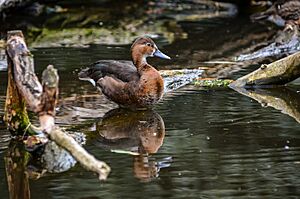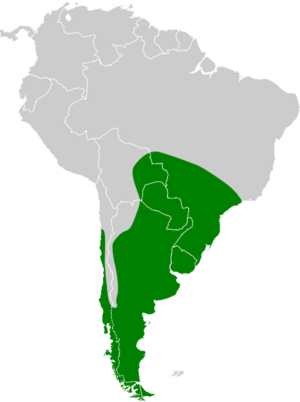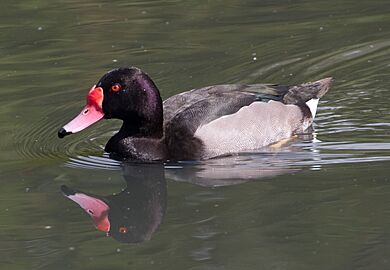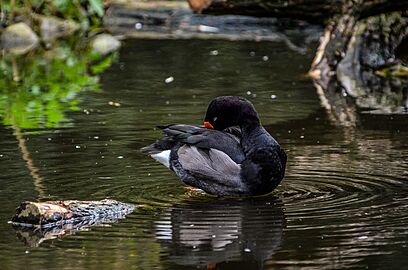Rosy-billed pochard facts for kids
Quick facts for kids Rosy-billed pochard |
|
|---|---|
 |
|
 |
|
| Male above, female below | |
| Conservation status | |
| Scientific classification | |
| Genus: |
Netta
|
| Species: |
peposaca
|
 |
|
| Synonyms | |
|
Metopiana peposaca Vieillot, 1816 |
|
The rosy-billed pochard (Netta peposaca) is a type of duck found in South America. It's also known as the rosybill. Even though it's called a "diving duck," it usually finds food by "dabbling." This means it dips its head into the water to eat seeds, roots, and water plants. The name Netta is an Ancient Greek word for "duck." Peposaca comes from the Guaraní language and means "showy wings." This is because it has a wide white stripe on its wings that you can only see when they are spread out. Male rosybills have a bright red bill with a round knob at its base.
These ducks live only in South America. You can find them in countries like Argentina, central Chile, Paraguay, Uruguay, and southern Brazil. Some rosybills from southern Argentina fly north during the colder months. They can reach Brazil and southern Bolivia. Sometimes, they even visit the Falkland Islands.
Contents
Understanding the Rosy-billed Pochard's Family Tree
The rosy-billed pochard is one of five types of ducks in the Netta group. This group is part of a larger duck family called Anatidae. Scientists first described the rosy-billed pochard in 1816. This happened in Paraguay and Argentina. It's a unique duck and is thought to be related to the southern pochard. Sometimes, rosybills even breed with other ducks, like the red-crested pochard. The rosybill is a single species, meaning it doesn't have different subspecies.
Discovering the Rosy-billed Pochard's Appearance
Rosy-billed pochards look different depending on if they are male or female. This is called sexual dimorphism.
Male Rosy-billed Pochard Features
Male rosybills have a purplish-black head, neck, and chest. Their sides are gray. They have a white area around their tail feathers. Their eyes are red, and their bill is bright red. The bill has a large, round knob that is also bright red. The rest of the bill fades to a pale pink before ending with a black tip. This red knob gets bigger and brighter during the mating season. When they fly, their dark feathers stand out against their white wing feathers. Their legs and feet are yellow to orange.
Female Rosy-billed Pochard Features
Female rosybills are not as colorful. They are mostly dull brown. Their bill is bluish-gray with a black tip. Their legs are yellow-orange to gray. The most noticeable thing about females is the white area around their tail feathers.
Young Rosybills and Size
Young rosybills look almost like the females, but their undersides are darker. Adult rosybills do not lose their bright colors after breeding, unlike some other ducks. Males are usually a bit bigger than females. Both sexes are similar in body size. Adult rosybills can grow to about 22 inches (56 cm) long. They weigh between 2.2 and 2.6 pounds (1 to 1.2 kg). Even though they are strong fliers, their wings are blunt. This means they have to flap their wings faster than many other ducks. They also find it a bit hard to take off. They don't walk very well on land. This is because their legs are set further back on their bodies. This helps them push through water when swimming. Their wingspan can be from 72 cm to 84 cm.
Where Rosy-billed Pochards Live and Their Home
Rosy-billed pochards build their nests in tall grasses in wet areas. These areas are mainly in central Argentina. You can also find them in shallow freshwater swamps, marshes, and small lakes.
These ducks move around a lot. Their movements depend on how much water is available. If an area gets dry in late summer, they have to move to find bigger water sources. By early fall, these new areas might also dry up. This forces them to move again to find water and food. When there is a lot of rain, their population can grow.
Understanding Rosy-billed Pochard Behavior
Rosy-billed pochards are very social ducks. They can gather in large groups with thousands of other ducks.
What Rosybills Eat
Rosybills eat both plants and some small animals. They mostly eat knotgrass and barnyard grasses. They also eat roots, sedges, and other water plants. Seeds are a very important part of their diet. Seeds give them lots of energy. This energy helps them stay warm, especially when it's cold. Even though they are called "diving ducks," they usually don't dive. They mostly dabble on the surface of the water. They might also tip their bodies upside down in shallow water. Sometimes, they eat grass on land. Because they eat many different things, they can adapt well to different food sources.
Rosy-billed Pochard Reproduction and Life Cycle
Each breeding season, a male and female rosy-billed pochard will form a pair. However, they do not stay together for life. In spring, they perform special courtship dances. These dances happen before they breed. Both male and female ducks do special movements. These include pretending to drink, mock preening (cleaning feathers), bobbing their heads, and stretching their necks. Breeding usually happens in October and November. They can breed as single pairs or in small groups.
Females build nests using plants. They line the nest with soft down feathers. Nests are usually built over the water at the edge of a pond or lake. Females have also been seen building nests in rice fields.
A female lays up to 10 eggs. The eggs are cream to greenish in color. Sometimes, a female might even lay her eggs in another bird's nest. The eggs are kept warm for 27 to 29 days. The young ducklings can fly within 50 to 75 days. Females raise the ducklings by themselves. Sometimes, ducklings from different mothers will join together. Then, a few females will raise all the young ducks as a group.
Rosy-billed Pochard Sounds
Like most birds, rosybills have different calls for different reasons. They make a "honk" sound, which is common for ducks. However, their honk is deeper than a mallard's honk. From the few recordings available, it seems their calls are quite quiet.
Rosy-billed Pochards and People
People use rosy-billed pochards in different ways. They are sometimes hunted for food. Some people keep them as pets or for display. They can also be seen in gardens. These ducks are sometimes seen as a problem in rice fields. They face a lot of hunting pressure in Argentina.
A big danger to these ducks is lead poisoning. In Argentina, lead shot is the only type of ammunition available for hunting. Studies have shown that rosy-billed pochards are more likely to swallow lead shot than other duck species. They might swallow the lead pellets because they think they are small stones. Ducks need stones in their gizzard (a part of their stomach) to help grind up food. When they swallow lead, it's very harmful to them. Lead can get into their bones and make them very sick. Because of this danger, scientists think that rosybill populations might be decreasing due to too much hunting.
It is fairly easy for people to buy these ducks, even online.
Protecting the Rosy-billed Pochard
The number of rosy-billed pochards is currently growing. Their groups are not broken up into small, separate parts. There isn't a special plan to help them recover right now. However, there is a system in place to watch their populations. There are also special conservation areas where rosybills live. They are found in at least one protected area.






